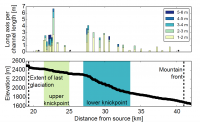CSDMS 2016 annual meeting poster CharlesShobe
Boulders and bedrock: Modeling dynamic feedbacks between hillslope-derived blocks and transient channel evolution
Gregory Tucker, CIRES and Department of Geological Sciences, University of Colorado Boulder Colorado, United States. gtucker@colorado.edu
Robert Anderson, INSTAAR and Department of Geological Sciences, University of Colorado Boulder Colorado, United States. robert.s.anderson@colorado.edu
Abstract:
Steep reaches of mountain rivers often host clusters of large (>1 m) blocks of rock despite having high transport capacity (Fig. 1). We argue that this distribution of blocks is a manifestation of a previously unrecognized negative feedback in which fast vertical river incision steepens adjacent hillslopes, which deliver large blocks to the channel. Blocks in the channel inhibit incision by both shielding the bed and enhancing form drag. We explore this feedback with one- and two-dimensional numerical models of channel-reach erosion in which block delivery by hillslopes depends on the river incision rate. Block dynamics in the channel are modeled explicitly, and form drag exerted on blocks is detracted from shear stress used to erode the channel bed. Hillslope block delivery is treated probabilistically, with the mean number of blocks delivered per channel length per time treated as a function of incision rate in the adjacent channel. When block delivery by the hillslopes is significant relative to the baselevel lowering rate, both the form of the channel reach and the timescales of reach profile evolution differ noticeably from the predictions of current theory. Results indicate that incision-dependent block delivery can explain the block distribution along Boulder Creek, Colorado, USA. The proposed negative feedback may significantly slow knickpoint retreat, channel adjustment to perturbations, and landscape response in comparison to rates predicted by current theory. We suggest that the influence of hillslope-derived blocks may complicate efforts to extract baselevel histories from transient river profiles. Future work includes construction of Landlab components to more explicitly treat hillslope block delivery processes in models of river incision.

Figure 1: Grain size and longitudinal profile data collected in Boulder
Creek. Each bar represents the sum of long axes
of all grains >1 m found in the channel along 10 m
of channel length. Stars show sites with no blocks >1 m.
Shaded regions indicate steepened reaches, or knickzones.
Large (>1 m) grains are much more prevalent in the
knickzone than upstream or downstream.
* Please acknowledge the original contributors when you are using this material. If there are any copyright issues, please let us know and we will respond as soon as possible.
